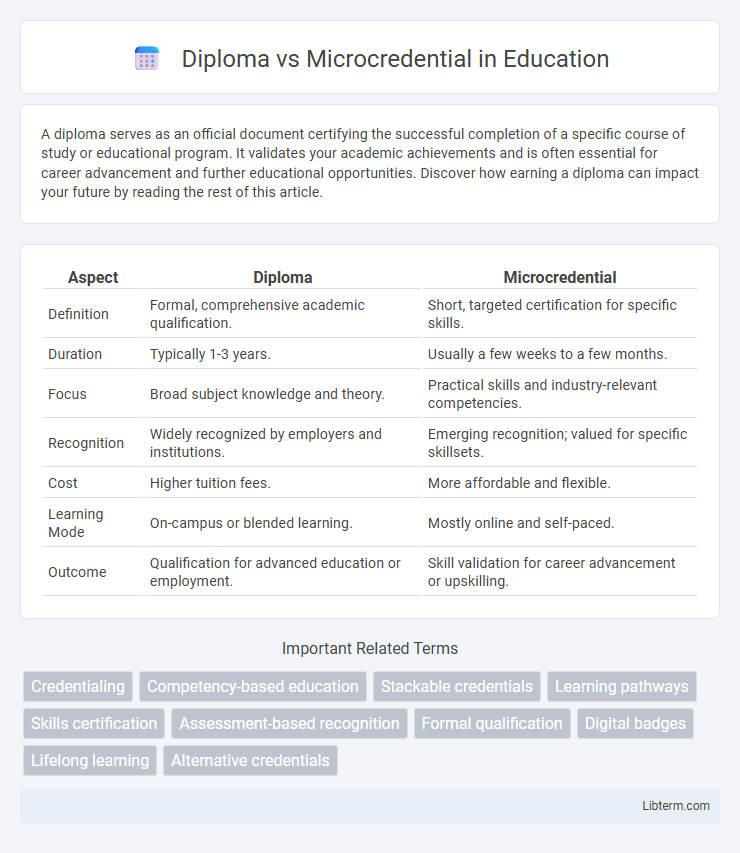A diploma serves as an official document certifying the successful completion of a specific course of study or educational program. It validates your academic achievements and is often essential for career advancement and further educational opportunities. Discover how earning a diploma can impact your future by reading the rest of this article.
Table of Comparison
| Aspect | Diploma | Microcredential |
|---|---|---|
| Definition | Formal, comprehensive academic qualification. | Short, targeted certification for specific skills. |
| Duration | Typically 1-3 years. | Usually a few weeks to a few months. |
| Focus | Broad subject knowledge and theory. | Practical skills and industry-relevant competencies. |
| Recognition | Widely recognized by employers and institutions. | Emerging recognition; valued for specific skillsets. |
| Cost | Higher tuition fees. | More affordable and flexible. |
| Learning Mode | On-campus or blended learning. | Mostly online and self-paced. |
| Outcome | Qualification for advanced education or employment. | Skill validation for career advancement or upskilling. |
Understanding Diplomas and Microcredentials
Diplomas are formal educational qualifications typically awarded after completing comprehensive programs that cover in-depth knowledge and skills in a specific field, often requiring months or years of study. Microcredentials are short, focused certifications that validate specific skills or competencies and are designed for rapid learning and immediate application in professional contexts. Understanding the scope and recognition of diplomas versus microcredentials helps learners choose the right credential based on career goals, industry demands, and time commitment.
Key Differences Between Diplomas and Microcredentials
Diplomas typically require longer study periods and provide comprehensive subject knowledge, while microcredentials focus on specific skills or competencies and can be completed quickly. Diplomas are recognized formal qualifications often used for career entry or advancement, whereas microcredentials enhance professional development and specialization. Institutions award diplomas through structured programs, whereas microcredentials often result from modular, flexible learning pathways tailored to current industry demands.
Duration and Time Commitment
Diplomas typically require a longer duration, ranging from several months to two years, demanding a substantial time commitment for comprehensive study and assessment. Microcredentials are designed for shorter learning periods, often completed within weeks or a few months, offering flexible and focused skill acquisition. This condensed format suits professionals seeking rapid upskilling without the extensive time investment of traditional diplomas.
Cost Comparison: Diploma vs Microcredential
Diplomas typically involve higher tuition fees and longer study durations, reflecting their comprehensive curriculum and accreditation value. Microcredentials offer a cost-effective alternative with lower fees and shorter completion times, catering to targeted skill acquisition. The affordability and flexibility of microcredentials appeal to professionals seeking specific expertise without the financial burden of a full diploma program.
Accreditation and Recognition
Diplomas typically hold formal accreditation from recognized educational institutions and government bodies, ensuring widespread acceptance and credibility in academic and professional settings. Microcredentials, often issued for specific skills or competencies, may vary in accreditation status but are gaining recognition through partnerships with industry leaders and professional organizations. The growing emphasis on skills-based learning is increasing acceptance of microcredentials alongside traditional diplomas, especially in rapidly evolving job markets.
Skills Acquired: Depth vs Breadth
Diplomas typically offer comprehensive skill development, providing in-depth knowledge and expertise across a broad subject area, making graduates well-prepared for specialized roles. Microcredentials focus on acquiring specific, targeted skills or competencies within a shorter timeframe, allowing learners to quickly adapt to emerging industry needs or enhance particular abilities. This contrast highlights diplomas' emphasis on mastery and breadth, while microcredentials prioritize agility and precise skill acquisition.
Career Pathways and Job Opportunities
Diplomas provide comprehensive education that equips students with in-depth knowledge and skills, making them suitable for traditional career pathways requiring formal qualifications and extensive training. Microcredentials offer targeted, skill-specific certifications that enhance employability by addressing current job market demands and enabling rapid upskilling or career shifts. Employers increasingly value microcredentials for their flexibility and relevance, complementing diplomas in expanding job opportunities across evolving industries.
Flexibility and Learning Formats
Diplomas typically require a fixed timeframe and a structured curriculum, limiting flexibility compared to microcredentials, which offer modular, on-demand learning formats tailored to individual schedules and career goals. Microcredentials emphasize short, competency-based courses that can be completed asynchronously online, enhancing accessibility and allowing learners to upskill or reskill rapidly. This adaptability makes microcredentials ideal for professionals seeking targeted expertise without the extended commitment of traditional diploma programs.
Ideal Candidates for Diplomas or Microcredentials
Diplomas are ideal for candidates seeking comprehensive knowledge and long-term career advancement in fields such as healthcare, engineering, or business management, often requiring a substantial time commitment. Microcredentials suit professionals aiming to quickly upskill or reskill specific competencies, such as digital marketing, data analytics, or project management, for immediate application and career flexibility. Both options provide valuable credentials, but diplomas emphasize depth and formal education, while microcredentials prioritize targeted learning and rapid skill acquisition.
Making the Right Choice for Your Future
Choosing between a diploma and a microcredential depends on your career goals, time commitment, and industry demands. Diplomas offer comprehensive education and deeper knowledge ideal for traditional professions, while microcredentials provide focused, flexible learning that addresses specific skills and emerging technologies. Assess the value of each in your target job market to align your credentials with future opportunities and rapid career advancement.
Diploma Infographic

 libterm.com
libterm.com